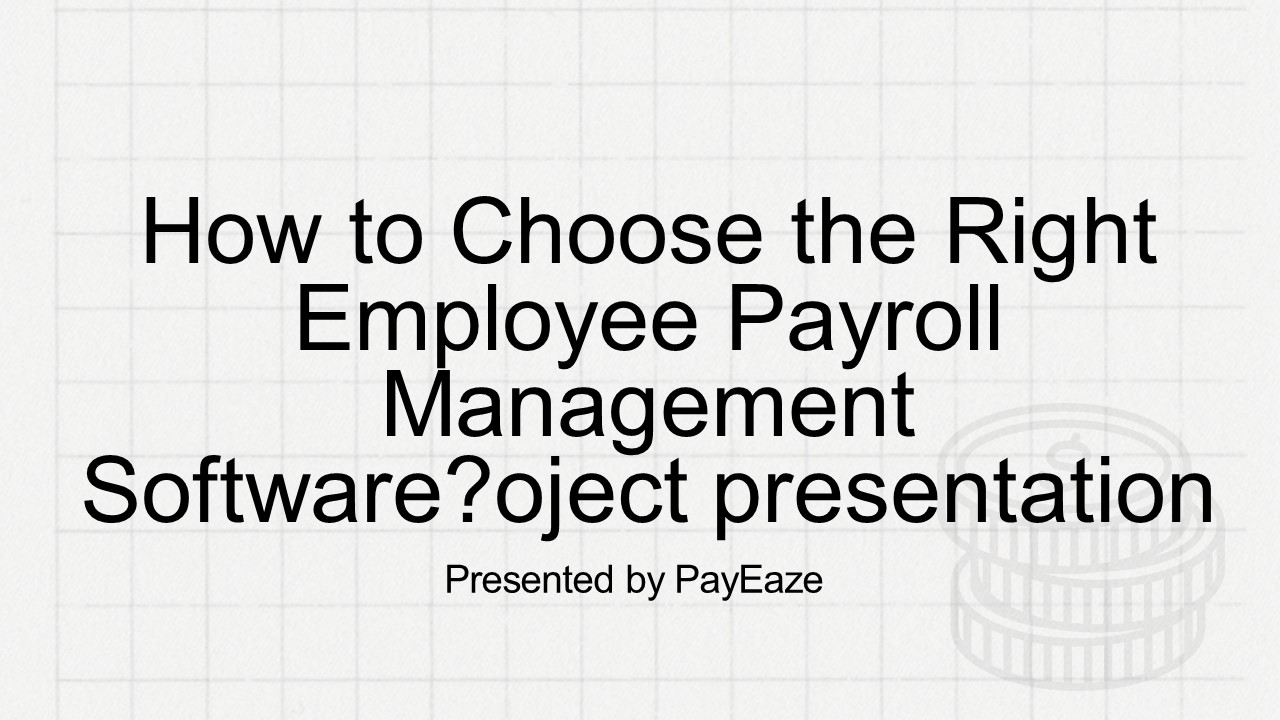Selecting the Appropriate Employee Payroll Management Software! - PowerPoint PPT Presentation
Title:
Selecting the Appropriate Employee Payroll Management Software!
Description:
The complexities of choosing the perfect employee payroll management software in today's fast-paced business landscape. This insightful blog delves into the significance of efficient payroll processing and introduces key features to look for, including automated payroll processing, tax compliance tools, and employee self-service portals. Exploring factors like cost, scalability, and system integration, the blog guides readers through the selection process while comparing cloud-based versus on-premise solutions and all-in-one versus specialised options. – PowerPoint PPT presentation
Number of Views:1
Title: Selecting the Appropriate Employee Payroll Management Software!
1
How to Choose the Right Employee Payroll
Management Software?oject presentation
Presented by PayEaze
2
How to Choose the Right Employee Payroll
Management Software?
Significance of Employee Payroll Management
Introduction
In the modern and ever-changing corporate realm,
the adept administration of Employee Payroll
Management Software emerges as a crucial
undertaking for organizations of every magnitude.
As businesses expand, the manual management of
payroll proves cumbersome and vulnerable to
errors. Thus, the significance of Employee
Payroll Management Software becomes apparent,
offering automated remedies to streamline payroll
procedures.
The precision and punctuality in payroll
processing hold pivotal importance in upholding
employee contentment and adherence to labor
regulations. Employee payroll management software
aids in the precise computation of salaries,
deductions, and taxes, thereby diminishing the
probability of errors and penalties.
3
Key Attributes of Employee Payroll Management
Software
Employee Self-Service Portals
Automated Payroll Processing
Several payroll systems furnish self-service
gateways enabling employees to access pay
statements, tax documents, and amend personal
particulars, augmenting employee involvement and
diminishing administrative overheads.
Contemporary payroll software automatizes payroll
computations, tax deductions, and direct
disbursements, economizing time and curbing
manual inaccuracies.
Tax Conformity Characteristics
Employee payroll management software remains
abreast of tax statutes and ordinances, ensuring
compliance and averting costly errors during tax
seasons.
4
Points to Contemplate When Selecting Payroll
Management Software
Integration with Existing Frameworks
Cost Evaluation
Assess the pricing framework of payroll software,
encompassing installation charges, subscription
schemes, and additional fees for supplementary
functionalities.
Verify compatibility with other software
frameworks such as accounting, human resources,
and time-monitoring tools to streamline processes
and data administration.
Scalability
Opt for software capable of accommodating the
growth of your business, catering to an expanding
workforce and burgeoning payroll requisites.
5
Different Varieties of Employee Payroll
Management Software
Cloud-based versus On-premise Solutions
All-in-one versus Specialized Solutions
Deliberate whether an all-encompassing human
resources and payroll suite or a specialized
payroll resolution better aligns with your
organizational requirements and financial
constraints.
Cloud-based software offers flexibility and
accessibility, whereas on-premise solutions
confer greater authority and security over
sensitive payroll data.
6
Selecting the Appropriate Employee Payroll
Management Software
Assessment of Business Requirements
Perusal of User Testimonials
Solicit feedback from current users to glean
insights into software efficacy, dependability,
and client satisfaction.
Identify specific payroll hurdles and
prerequisites to narrow down software
alternatives that resonate with your
organizational goals.
Surveying Available Alternatives
Explore various payroll software providers,
juxtaposing functionalities, user testimonials,
and customer service provisions.
7
Implementation of Employee Payroll Management
Software
Data Transference
Training and Assistance
Delineate and execute data transference
strategies meticulously to transfer extant
payroll data accurately and securely to the new
software.
Invest in comprehensive training regimens to
ensure seamless assimilation of the novel payroll
system among employees and administrators.
8
Advantages of Utilizing Employee Payroll
Management Software
Precision and Adherence
Time and Monetary Savings
Sophisticated payroll software mitigates errors
and ensures conformity with tax statutes and
labor regulations, mitigating the risks of fines
and penalties.
The automation of payroll processes diminishes
manual workloads and administrative expenses,
permitting human resource teams to concentrate on
strategic ventures.
9
Challenges Encountered in Implementing Payroll
Management Software
Initial Establishment and Learning Curve
Concerns Regarding Data Security
The safeguarding of sensitive employee data from
breaches and cyber threats necessitates robust
security measures and compliance protocols.
The transition to a fresh payroll system may
necessitate time and resources for setup,
configuration, and personnel training,
temporarily impacting productivity.
10
Best Practices for Utilizing Employee Payroll
Management Software
Regular Updates and Maintenance
Case Studies Instances of Successful
Implementation
Explore real-life instances of organizations that
have efficaciously implemented employee payroll
management software to streamline operations and
accomplish business objectives.
Stay abreast of software updates and patches to
address security vulnerabilities and enhance
system performance at regular intervals.
Implement data backup protocols and encryption
measures to fortify payroll data against loss,
corruption, or unauthorized access.
11
Conclusion
The selection of appropriate employee payroll
management software constitutes a pivotal
decision that profoundly influences the
efficiency, precision, and compliance of payroll
processes within an organization. By factoring in
key considerations such as functionalities,
costs, scalability, and user feedback,
enterprises can opt for a solution that caters to
their unique requisites and enhances overall
productivity.
Read More - PayEaze































